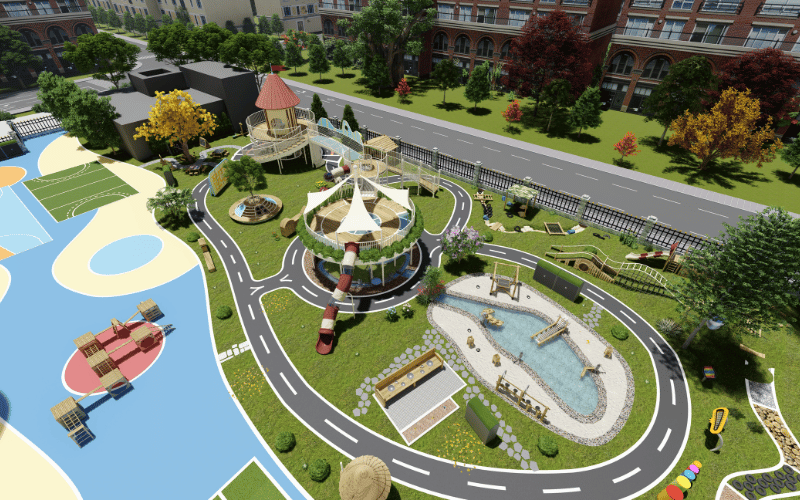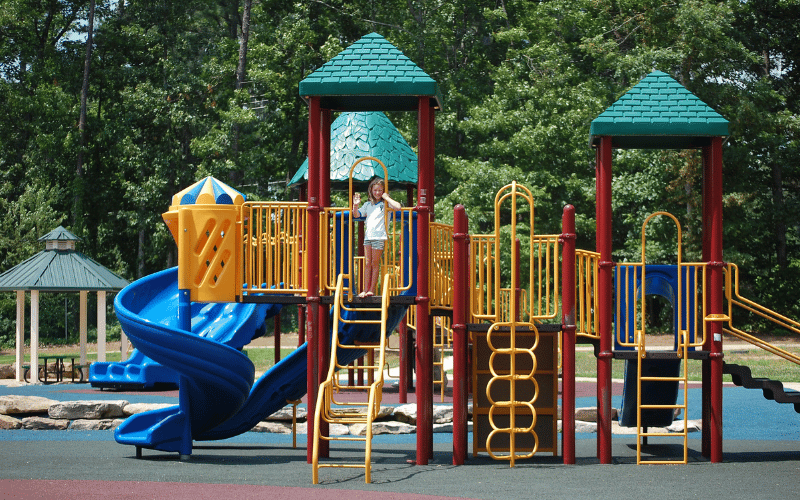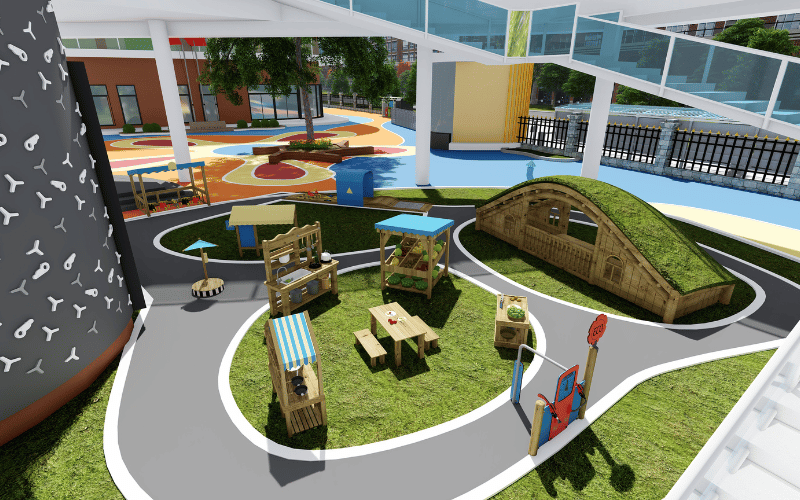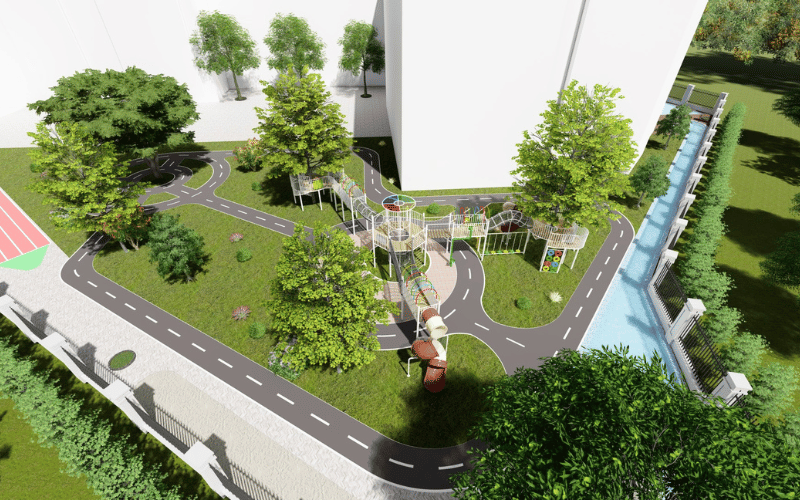A small playground typically ranges from 500 to 2,000 square feet.
Understanding the size of a playground is crucial for proper planning, ensuring safety, and designing an adequate space. The available space determines the number and type of play structures, seating, and safety zones required, while also providing sufficient room for children to move freely. Whether for a backyard, school, or community park, choosing the right size helps maximize fun, accessibility, and functionality.
Table of Contents
ToggleWhat Defines a Small Playground?
A small playground typically ranges from 500 to 2,000 square feet, making it an ideal choice for businesses or communities with limited space. These compact play areas focus on maximizing functionality within a smaller footprint, ensuring they deliver engaging experiences without requiring extensive real estate. Small playgrounds often cater to specific age groups or activity types, allowing for a more tailored design that meets the needs of the target audience.
The primary purpose of a small playground is to provide a cost-effective solution for recreational or business needs. By utilizing space efficiently, these playgrounds reduce construction and maintenance costs while still offering a safe and enjoyable environment for children. For example, a small indoor playground in a café or retail store can enhance the customer experience by keeping children entertained, encouraging more extended visits, and promoting repeat business.
Designed for limited spaces, small playgrounds often incorporate modular or multifunctional equipment to maximize every square foot. Features like climbing walls with built-in storage, compact slides, or interactive panels ensure that the area remains engaging without feeling overcrowded. These designs also allow for flexibility, enabling businesses or communities to adapt the space as needs evolve.
By focusing on compactness, affordability, and adaptability, small playgrounds serve as a practical and impactful solution for creating recreational spaces in urban areas, small businesses, or community centers.
Common Dimensions and Examples
500-1,000 Square Feet: Perfect for Daycares and Urban Courtyards
Playgrounds within the 500-1,000 square foot range are compact yet functional, making them ideal for spaces with significant size constraints. These dimensions are well-suited for daycares, where the primary focus is on providing safe, age-appropriate activities for young children. For example, a daycare playground might include a small climbing structure, a slide, and interactive panels that encourage sensory play. These features ensure children stay engaged while maintaining a safe and manageable environment for caregivers.
Urban courtyards also benefit from playgrounds in this size range. In densely populated areas, these compact play zones offer a much-needed recreational space for families. Designers often incorporate vertical elements, such as climbing walls or tiered play structures, to maximize the use of limited square footage. Additionally, features like benches or shaded areas can enhance the space for parents and guardians, creating a welcoming environment for all.
1,000-2,000 Square Feet: Great for Small Community Parks and Indoor Play Zones
Playgrounds measuring 1,000-2,000 square feet provide more flexibility, making them suitable for small community parks or indoor play areas. These spaces can accommodate a wider range of activities and age groups, offering something for toddlers, older children, and even parents. For instance, a small community park might include a combination of swings, slides, and open areas for free play. Adding features like picnic tables or walking paths can further enhance the park’s appeal, encouraging families to spend more time there.
Indoor play zones within this size range often focus on creating a multi-functional environment. For example, a 1,500-square-foot indoor playground might include a soft play area for toddlers, a small climbing structure for older kids, and a seating area for parents. Businesses can also incorporate modular equipment that allows for easy reconfiguration, enabling the space to adapt to different events or customer needs. This versatility ensures the playground remains engaging and relevant over time.
By understanding these size categories and their practical applications, businesses and communities can design playgrounds that maximize both functionality and user satisfaction.

Key Features of Small Playgrounds
Compact Play Structures
Small playgrounds often include compact play structures designed to fit within limited spaces while still offering engaging activities for children. These structures typically feature slides, climbing frames, and tunnels that encourage physical activity and imaginative play. For example, a single play unit might combine a small slide with a climbing wall and a crawl-through tunnel, allowing children to explore multiple activities in one area. By focusing on vertical designs, these structures maximize the use of available space without overcrowding the playground.
Ground-Level Play Elements
Ground-level play elements play a crucial role in small playgrounds by providing accessible and inclusive activities for children of all abilities. Features like sandboxes, sensory panels, and interactive games encourage creative and tactile play while requiring minimal space. For instance, a sensory panel with spinning gears or musical elements can engage children in hands-on learning, making the playground both fun and educational. Sandboxes, on the other hand, offer a classic play option that fosters social interaction and creativity. These ground-level features ensure that small playgrounds remain versatile and welcoming to a diverse group of users.
Multi-Purpose Equipment
To make the most of limited square footage, small playgrounds often rely on multi-purpose equipment that serves multiple functions. For example, a climbing frame might double as a seating area for parents or a shaded structure for hot days. Similarly, a play table with built-in storage can provide a space for arts and crafts while keeping supplies organized and out of the way. These versatile designs not only save space but also enhance the overall functionality of the playground, ensuring it meets the needs of both children and caregivers.
By incorporating compact structures, ground-level elements, and multi-purpose equipment, small playgrounds deliver engaging and efficient play experiences that maximize the potential of limited spaces.
Benefits of Small Playgrounds
Cost-Effective and Easy to Maintain
Small playgrounds offer a budget-friendly solution for creating recreational spaces. Their compact size reduces construction costs, as they require fewer materials and less labor to build. Maintenance also becomes more manageable, with smaller areas needing less frequent repairs and lower upkeep expenses. For example, cleaning and inspecting a 1,000-square-foot playground takes significantly less time and resources compared to larger facilities. This cost-effectiveness makes small playgrounds an attractive option for schools, daycares, and community organizations with limited budgets.
Additionally, small playgrounds often use modular or multi-functional equipment, which simplifies maintenance. Modular designs enable the easy replacement of individual components, thereby minimizing downtime and repair costs. By keeping maintenance straightforward and affordable, these playgrounds ensure long-term usability without straining financial resources.
Accessible for Urban or Space-Constrained Areas
Small playgrounds thrive in urban environments and areas with limited space. Their compact design allows them to fit into courtyards, rooftops, or even unused corners of a neighborhood. This accessibility brings play opportunities closer to families who may not have access to larger parks or recreational facilities. For instance, a small playground in a busy city block can transform an underutilized space into a vibrant community hub.
Urban planners and developers often prioritize small playgrounds because they can be integrated seamlessly into mixed-use developments. By placing these play areas near residential buildings, schools, or shopping centers, they create convenient and accessible spaces for families. This proximity encourages frequent use, fostering a sense of community and improving the quality of life in densely populated areas.
Encourages Local, Community-Based Play
Small playgrounds play a vital role in building strong, community-focused environments. Their intimate size naturally fosters interaction among children and parents, creating opportunities for social bonding. Unlike larger, more impersonal parks, small playgrounds encourage neighbors to connect and form relationships. For example, a playground in a residential complex can serve as a gathering spot where families meet regularly, strengthening the sense of community.
These playgrounds also support local initiatives by providing a space for community events, such as playdates, small festivals, or educational workshops. Their manageable size makes them ideal for hosting activities that bring people together without requiring extensive planning or resources. By promoting local engagement, small playgrounds contribute to a more connected and supportive community.
Through their cost-effectiveness, accessibility, and ability to foster community connections, small playgrounds deliver significant benefits that extend beyond their physical size. They create spaces where families can gather, children can play, and communities can thrive.
Practical Applications
Daycares and Preschools
Small playgrounds fit perfectly into daycares and preschools, where space is often limited but the need for safe, engaging play areas remains high. These facilities utilize compact play structures, including small slides, climbing frames, and sensory panels, to create age-appropriate environments that promote physical activity and social interaction. For example, a 700-square-foot playground at a preschool might include a soft play area for toddlers, a mini climbing wall, and a sandbox. These features not only support motor skill development but also provide a safe space for children to explore and play under the supervision of caregivers.
By focusing on compact, multi-functional equipment, daycares and preschools can maximize the use of their available space while ensuring the playground meets the developmental needs of young children. This approach also keeps maintenance manageable, allowing staff to focus on creating enriching experiences for their students.
Urban Installations: Rooftops and Pocket Parks
In urban areas, small playgrounds transform underutilized spaces, such as rooftops and pocket parks, into vibrant play zones. Rooftop playgrounds, for instance, offer a creative solution for schools, residential buildings, or community centers that lack ground-level space. Designers often incorporate safety features, such as padded flooring and enclosed play structures, to ensure children can play securely at elevated heights. A rooftop playground might include a small climbing structure, a sensory play wall, and shaded seating for parents, creating a functional and enjoyable space in the heart of the city.
Pocket parks, which are small green spaces tucked into urban neighborhoods, also benefit from compact playground designs. These parks often feature simple play elements, such as swings, slides, or interactive panels, providing a much-needed recreational area for families in densely populated areas. By integrating small playgrounds into these spaces, urban planners can enhance community engagement and improve the quality of life for residents.
Indoor Play Areas in Restaurants or Malls
Small playgrounds also thrive in indoor settings, such as restaurants, shopping malls, or family entertainment centers. These play areas keep children entertained while parents dine, shop, or relax, enhancing the overall customer experience. For example, a restaurant might dedicate a 500-square-foot corner to a soft play zone with climbing mats, a ball pit, and interactive panels. This setup not only attracts families but also encourages more extended visits and repeat business.
In shopping malls, small indoor playgrounds often serve as a central attraction for families. A 1,000-square-foot play area might include a combination of slides, tunnels, and sensory activities, catering to children of various ages. These spaces offer a safe and engaging environment for children, enabling parents to shop with peace of mind. By incorporating small playgrounds into their design, businesses can create family-friendly environments that boost customer satisfaction and loyalty.
Through these practical applications, small playgrounds demonstrate their versatility and ability to adapt to various settings, from educational facilities to urban spaces and commercial venues. Their compact size and thoughtful design make them a valuable addition to any community or business seeking to create engaging, family-friendly environments.
Tips for Designing a Small Playground
Focus on Multi-Functional Equipment
When designing a small playground, prioritize multi-functional equipment that serves multiple purposes within a compact footprint. For example, a climbing structure with integrated slides and tunnels enables children to engage in various activities without occupying excessive space. Similarly, interactive panels that combine sensory play with educational elements, such as alphabet boards or musical features, add value while conserving space. Modular designs also offer flexibility, enabling you to reconfigure the playground as needs evolve. By choosing versatile equipment, you can create a dynamic play environment that keeps children engaged and maximizes the utility of every square foot.
Prioritize Safety and Accessibility
Safety and accessibility should remain at the forefront of any playground design, especially in smaller spaces where children may interact more closely. Use soft, impact-absorbing surfaces like rubber tiles or padded mats to reduce the risk of injuries during play. Ensure that all equipment meets safety standards and includes features like rounded edges, secure handrails, and non-slip surfaces.
Accessibility is equally essential, as it ensures children of all abilities can enjoy the playground. Incorporate ground-level play elements, such as sensory panels or sandboxes, to provide inclusive activities for children with mobility challenges. Wide pathways and ramps also improve accessibility, making the space welcoming for everyone. By addressing safety and accessibility, you create a playground that fosters a secure and inclusive environment for all users.
Use Creative Layouts to Maximize Space
A well-thought-out layout can make even the smallest playground feel spacious and inviting. Start by dividing the area into zones based on activity types, such as climbing, sliding, and sensory play. This approach helps organize the space and prevents overcrowding in any one area. Vertical designs, like climbing walls or tiered play structures, make excellent use of limited square footage by adding height to the playground.
Incorporate open spaces for free play or seating areas for parents to enhance the overall functionality of the playground. Use natural or artificial barriers, such as planters or low walls, to define zones without making the space feel confined. Creative layouts not only optimize the available space but also enhance the flow and usability of the playground, ensuring a better experience for both children and caregivers.
By focusing on multi-functional equipment, prioritizing safety and accessibility, and using innovative layouts, you can design a small playground that feels larger than its dimensions and delivers a fun, engaging experience for all.
Frequently Asked Questions
Q: What is the average size of a playground?
A: Playground sizes vary based on their purpose and the community they serve. Small playgrounds typically range from 500 to 2,000 square feet, while medium-sized playgrounds occupy 5,000 to 10,000 square feet. Larger playgrounds, exceeding 10,000 square feet, can accommodate more equipment and activities, making them ideal for larger groups of children.
Q: What space requirements should I consider for a small playground?
A: When planning a small playground, focus on the available space and the dimensions of the equipment. Ensure at least 6 feet of safety space around each play structure to prevent injuries and allow children to move freely. This spacing is crucial for creating a safe and enjoyable play environment.
Q: What types of play equipment are suitable for a smaller playground?
A: Compact play structures, swings, slides, and climbing equipment work well in smaller playgrounds. Prioritize designs that maximize engagement and encourage interactive play. Choose equipment that fits the playground’s size while offering diverse play opportunities for children.
Q: How does playground size affect the play experience?
A: Playground size directly influences the play experience. Smaller playgrounds may limit the number of structures and the capacity for simultaneous play. However, thoughtful designs and multifunctional equipment can create engaging play environments that offer a variety of activities, even in limited spaces.
Q: Why are playground dimensions important?
A: Playground dimensions are critical for safety, accessibility, and the overall play experience. Adequate space ensures safe movement around equipment and accommodates multiple children. Understanding dimensions also helps in selecting the right playground size for your community and meeting local safety regulations.
Q: Can I create a small playground in my community?
A: Absolutely! You can create a small playground by working with local playground consultants and assessing the space needed for various structures. Involving the community in the planning process ensures the playground meets the needs of local families and children.
Q: What are the typical sizes for commercial playgrounds?
A: Commercial playgrounds are usually larger than residential or community playgrounds. Medium-sized commercial playgrounds range from 5,000 to 10,000 square feet and include a variety of equipment to engage more children. These playgrounds often feature complex structures and enhanced safety measures.
Q: How can I ensure safety in a small playground?
A: To ensure safety, choose equipment that meets safety standards and provide adequate spacing around each structure. Regular maintenance and inspections help identify potential hazards. Use shock-absorbing surfaces like rubber mulch or mats to cushion falls and enhance safety for children.
Q: What are the best options for playground surface materials?
A: Playground surface materials play a key role in safety and accessibility. Popular options include grass, sand, wood chips, and rubber surfaces. For small playgrounds, rubber mulch or poured-in-place rubber are excellent choices due to their shock-absorbing properties and low maintenance, creating a safer play environment.
Conclusion
In summary, designing a small playground requires careful consideration of space, functionality, safety, and accessibility. By focusing on multifunctional equipment, creative layouts, and inclusive features, you can create a vibrant play area that meets the needs of both children and caregivers. For more insights or tailored advice, consider exploring additional resources or consulting with a playground design expert to bring your vision to life.








